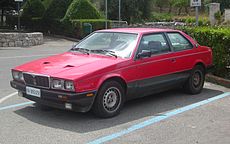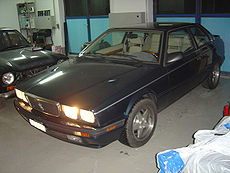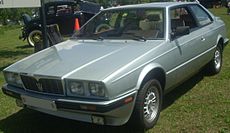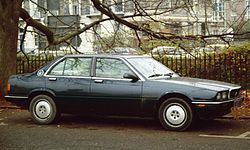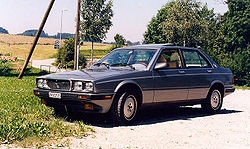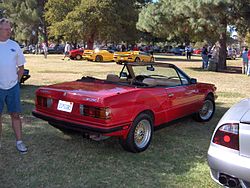- Maserati Biturbo
-
Maserati Biturbo 
Manufacturer Maserati Production 1981-1994 Assembly Modena, Italy Predecessor Maserati Merak Successor Maserati Shamal and Ghibli II Class Sports / Luxury Body style 2-door coupé
4-door sedan
2-door cabrioletLayout FR layout Engine 2.0L V6
2.5L V6
2.8L V6, twin turbochargedTransmission 5-speed manual
3-speed automaticWheelbase 251 cm (98.8 in) (Coupé)
260 cm (102.4 in) (Sedan, 228)
240 cm (94.5 in) (Spyder)Length 415 cm (163.4 in) (Coupé)
440 cm (173.2 in) (Sedan)
404 cm (159.1 in) (Spyder)
445 cm (175.2 in) (228)Width 171 cm (67.3 in) (Coupé, Spyder)
173 cm (68.1 in) (Sedan)
186 cm (73.2 in) (228)Height 131 cm (51.6 in) (Coupé, Spyder, 228)
136 cm (53.5 in) (Sedan)Designer Pierangelo Andreani The Maserati Biturbo is a sports car introduced by Maserati in 1981. The Biturbo is a two-door, four-seater notchback coupé (of somewhat smaller dimensions than the BMW 3 Series of the time) featuring, as the name implies, a two-litre V6 engine with two turbochargers and a luxurious interior. The car was designed by Pierangelo Andreani, an engineer from the De Tomaso team, somewhat influenced by the design of the newer Quattroporte III (Italdesign Giugiaro), as can be observed on the front fascia.
Export versions came initially with a 2.5L V6, after 1989 it was enlarged to 2.8 Litres, while for Italy a two-litre high-performance version was originally produced (to avoid the 38% sales tax imposed at the time on cars displacing more than 2000 cc). The aluminum 90 degree SOHC V6 engine was roughly based on the 2.0 L Merak engine, itself based on earlier V8 Formula One Maserati engines, designed by Giulio Alfieri (1924–2002). The carbureted 2.5L engine produced 185 hp (138 kW) and 208 lb·ft (282 N·m) of torque in North American spec and slightly more elsewhere. Fuel injection was fitted in 1987 raising power to 187 hp (139 kW). In 1989 the 2.8L engine bumped power to 225 hp (168 kW) and 246 lb·ft (334 N·m) of torque for North America and 250 hp (186 kW) for Europe.
All Maserati models from the Biturbo's introduction in 1981 until 1997 (except the Quattroporte) were based on the original Biturbo architecture, among them the four-door 420/425 and 4.24v, the Spyder, the Karif, the 228 and 2.24v, the Maserati Racing and the later Shamal and Ghibli II, as well as Maserati Barchetta which used an ultimate version of the V6 engine.
Contents
History
When Alessandro de Tomaso acquired Maserati in 1976, he had ambitious plans for the marque. His plan was to combine the prestige of the Maserati brand with a sports car that would be more affordable than the earlier high-priced models that had traditionally made up the Maserati range. In fact, Maserati ceased making supercars like the ones developed under Citroën ownership altogether, like the Bora and Khamsin.
The Biturbo was initially a strong seller and brought Italian prestige to a wide audience, with sales of about 40,000 units. Sales figures fell in subsequent years. De Tomaso later sold the company to Fiat.
It is number 28 in the BBC book of "Crap Cars" and is Time Magazine's worst car of 1984.
The Biturbo competed unsuccessfully in the British Touring Car Championship in the late 1980s, the European Touring Car Championship and the World Touring Car Championship (1987).
Biturbo engines
The Maserati Biturbo was the first ever production biturbo engine. The 2 liter version featured wet aluminium sleeves coated with Nikasil. The last street version featured over 150 hp/liter and 140 ft·lbf (190 N·m)/liter torque.
A V6 1996 cc DOHC 36 valve engine was developed but never manufactured.[1]
Série Displacement Head Fuel system Model AM 452 2000 cc 18 valves carburetor Biturbo, Biturbo S AM 453 2500 cc 18 valves carburetor Biturbo 2500 AM 470 2000 cc 18 valves injection Biturbo i AM 471 2000 cc 18 valves injection Si, 2.22S, 2.22SR, 4.18, 4.30, Spyder AM 472 2500 cc 18 valves injection Biturbo 2500i AM 473 2800 cc 18 valves injection 4.30, 222SR, Spyder, Karif AM 475 2000 cc 24 valves injection 2.24, 4.24, Spyder AM 490 2000 cc 24 valves injection Racing, Barchetta Stradale AM 495 2000 cc 24 valves injection Ghibli II AM 496 2000 cc 24 valves injection Ghibli Cup AM 477 2800 cc 24 valves injection 2.22 4V, 430 4V, Ghibli II AM 501 2000 cc 24 valves injection Barchetta Corsa Biturbo
The first Biturbo version was introduced in December 1981 as a two door coupe. The Biturbo name disappeared when the car was significantly redesigned in 1988 and after 1994 became the Ghibli II.
Versions:
Model Years Engine Displacement Power Fuel system Notes Biturbo 1982-85 V6 ohc 1995 cc 180 hp carburetor, turbo Only Italy Biturbo E 1983-85 V6 ohc 2491 cc 205 hp carburetor, turbo Only 250 Manufactured Biturbo S 1983-85 V6 ohc 1995 cc 205 hp carburetor, turbo Only Italy Biturbo 2.5 S 1984-87 V6 ohc 2491 cc 196 hp carburetor, turbo Catalysator Biturbo 1985-87 V6 ohc 1995 cc 180 hp carburetor, turbo Only Italy Biturbo 2.5 E 1985-88 V6 ohc 2491 cc 185 hp carburetor, turbo Catalysator Biturbo S 1985-86 V6 ohc 1995 cc 210 hp carburetor, turbo Only Italy Biturbo i 1986-90 V6 ohc 1995 cc 185 hp Fuel injection, turbo Only Italy Biturbo Si 1987-88 V6 ohc 1995 cc 220 hp Fuel injection, turbo Only Italy Biturbo 2.5 Si 1987-88 V6 ohc 2491 cc 188 hp Fuel injection, turbo Catalysator 2.24V 1988-92 V6 dohc 1996 cc 245 hp Fuel injection, turbo Only Italy 222 4v 1988-91 V6 dohc 2790 cc 279 hp Fuel injection, turbo Catalysator 222 E 1988-90 V6 ohc 2790 cc 250 hp Fuel injection, turbo 222 E 1988-90 V6 ohc 2790 cc 225 hp Fuel injection, turbo Catalysator 222 E 1988-90 V6 ohc 2790 cc 290 hp Fuel injection, turbo With "Modena Performance Pack" 222 SE 1990-91 V6 ohc 2790 cc 250 hp Fuel injection, turbo 222 SE 1990-91 V6 ohc 2790 cc 225 hp Fuel injection, turbo Catalytic converter in US (225 bhp) 2.24V 1991-93 V6 dohc 1996 cc 245 hp Fuel injection, turbo Only Italy 2.24V 1991-93 V6 dohc 1996 cc 240 hp Fuel injection, turbo Catalysator, Only Italy 222 SR 1991-93 V6 ohc 2790 cc 225 hp Fuel injection, turbo Catalysator Racing 1991-91 V6 dohc 1996 cc 285 hp Fuel injection, turbo See also:Maserati Racing
420/425/430
Two years after Biturbo introduction was unveiled four door family version. This version has longer wheelbase, 2.6 metres (100 in). The four door version was replaced in 1994 with Maserati Quattroporte IV.
Versions:
Model Years Engine Displacement Power Fuel system Notes 425 1983-89 V6 ohc 2491 cc 200 hp carburetor, turbo 420 1985-88 V6 ohc 1995 cc 180 hp carburetor, turbo Only Italy 420i 1986-88 V6 ohc 1995 cc 190 hp Fuel injection, turbo 420 S 1986-88 V6 ohc 1995 cc 210 hp carburetor, turbo Only Italy 430 1987-90 V6 ohc 2790 cc 225 hp Fuel injection, turbo Catalysator 425i 1987-90 V6 ohc 2491 cc 188 hp Fuel injection, turbo Catalysator 422 1988-90 V6 dohc 1996 cc 220 hp Fuel injection]], turbo Catalysator 4.18v 1990-94 V6 ohc 1995 cc 220 hp Fuel injection]], turbo Catalysator 4.24v 1990-92 V6 dohc 1996 cc 245 hp Fuel injection, turbo Only Italy 4.24v II 1991-94 V6 dohc 1996 cc 240 hp Fuel injection, turbo Catalysator 430 4v 1991-94 V6 dohc 2790 cc 279 hp Fuel injection, turbo Catalysator See also:Maserati 420
Spyder
The Spyder version was introduced in Turin Motor Show in 1984. The car was designed and built by Zagato. The Spyder version has shorter wheelbase, 2.4 metres (94 in). On this shorter chassis the sporty hardtop Karif was later developed.
Versions:
Model Years Engine Displacement Power Fuel system Notes Spyder 1984-88 V6 ohc 1995 cc 180 hp carburetor Only Italy Spyder 2.5 1984-88 V6 ohc 2491 cc 192 hp carburetor, turbo Catalysator Spyder i 1986-87 V6 dohc 1996 cc 185 hp Fuel injection, turbo Spyder i 1987-88 V6 dohc 1996 cc 195 hp Fuel injection, turbo Spyder 2.5i 1988-89 V6 ohc 2491 cc 188 hp Fuel injection, turbo Catalysator Spyder 2.8i 1989-91 V6 ohc 2790 cc 250 hp Fuel injection, turbo Spyder 2.8i 1989-91 V6 ohc 2790 cc 225 hp Fuel injection, turbo Catalysator Spyder i 1989-91 V6 dohc 1996 cc 220 hp Fuel injection, turbo Catalysator, Only Italy Spyder III 1991-94 V6 dohc 1996 cc 245 hp Fuel injection, turbo Only Italy Spyder III 2.8 1991-94 V6 dohc 2790 cc 225 hp Fuel injection, turbo Catalysator Spyder III 1991-94 V6 dohc 1996 cc 240 hp Fuel injection, turbo Catalysator, Only Italy 228
The Maserati 228 is a two-door Gran turismo model, targeting the same markets as had earlier bought 3500 GTs and Mexicos. The 228 was introduced at the 1986 Turin Motor Show, it uses the longer four-door chassis and the bigger 2.8 litre biturbo engine in a two door coupe form with a more luxurious interior than the usual two door cars. 469 examples of the 228 were built up until 1992.
Versions:
Model Years Engine Displacement Power Fuel system Notes 228 1986-92 V6 ohc 2790 cc 250 hp Fuel injection, turbo 228 1986-92 V6 ohc 2790 cc 225 hp Fuel injection, turbo Catalysator 222 1988-92 V6 dohc 1996 cc 220 hp Fuel injection, turbo Catalysator, Only Italy - This article is partly based on a translation of the article Maserati Biturbo from the Swedish Wikipedia.
References
External links
Maserati 1946-1969 1970-1979 1980-1999 Biturbo · 420 · Spyder I · Quattroporte III Royale · Racing ·Shamal · Karif · Barchetta · Ghibli II · Quattroporte IV · 3200 GT2000-present Racing Vehicles Concept Cars Maserati road car timeline, 1950s–present Type 1950s 1960s 1970s 1980s 1990s 2000s 2010s 0 1 2 3 4 5 6 7 8 9 0 1 2 3 4 5 6 7 8 9 0 1 2 3 4 5 6 7 8 9 0 1 2 3 4 5 6 7 8 9 0 1 2 3 4 5 6 7 8 9 0 1 2 3 4 5 6 7 8 9 0 1 2 Ownership Orsi family Citroën De Tomaso Fiat S.p.A. Executive Biturbo Luxury Quattroporte QP II QP III QP IV QP V GT A6 3500 GT Sebring 228 Ghibli II 3200GT Coupé 5000 GT Ghibli Khamsin Shamal GranTurismo Mistral Karif 2+2 Mexico Kyalami Indy Mid-engine Bora MC12 Merak SUV Kubang Categories:- Maserati vehicles
- Sports cars
- Rear wheel drive vehicles
- Sports sedans
- Coupes
- Convertibles
- 1980s automobiles
- 1990s automobiles
- Vehicles introduced in 1981
- Licence to Kill
Wikimedia Foundation. 2010.

